A GIANT CONCERN
Efforts under way to save baobab trees from being destroyed by the bushveld’s biggest animal
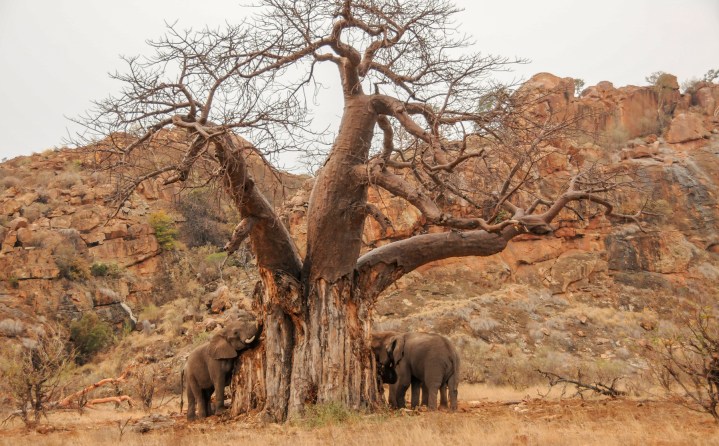
Evidence is mounting that elephants are killing ancient baobab trees in our regional parks, and saplings are increasingly hard to find. What’s driving the loss?
Days before the 2022 dry season ended, Clive Stockil stood in front of a 1,000-year-old baobab on the Runde River floodplain in Gonarezhou National Park, Zimbabwe. A recipient of the inaugural Prince William Award for Conservation in Africa, and founder of Chilo Gorge Safari Lodge, Stockil has lived in the area all his life. He knows individual trees.
This particular specimen was in flower, with great bowls of pollen and nectar on offer to bats. It was also decked out in wire mesh fencing, wrapped firmly around its portly torso to a height of 3m from the ground – a low-tech method of elephant protection.
Yet the mesh was not enough. Stretching out around the giant baobab were long furrows in the sandy earth. A renegade elephant, denied access to the trunk, had spent considerable energy digging up and consuming its moist roots. Whether the giant tree would survive would have to be seen.
The strange, smooth bark of baobabs (Adansonia digitata) has long been eaten by elephants. People, too, have used its bark for rope and woven items and eaten its vitamin C-rich fruit. Baobabs have evolved to cope with such attention. Given time, the bark heals over and the baobab continues clocking up years on centuries-long timelines. Even roots can recover.
Their great age, size and bulbous shape have made baobabs important heritage symbols, let alone keystone species in semi-arid ecosystems.
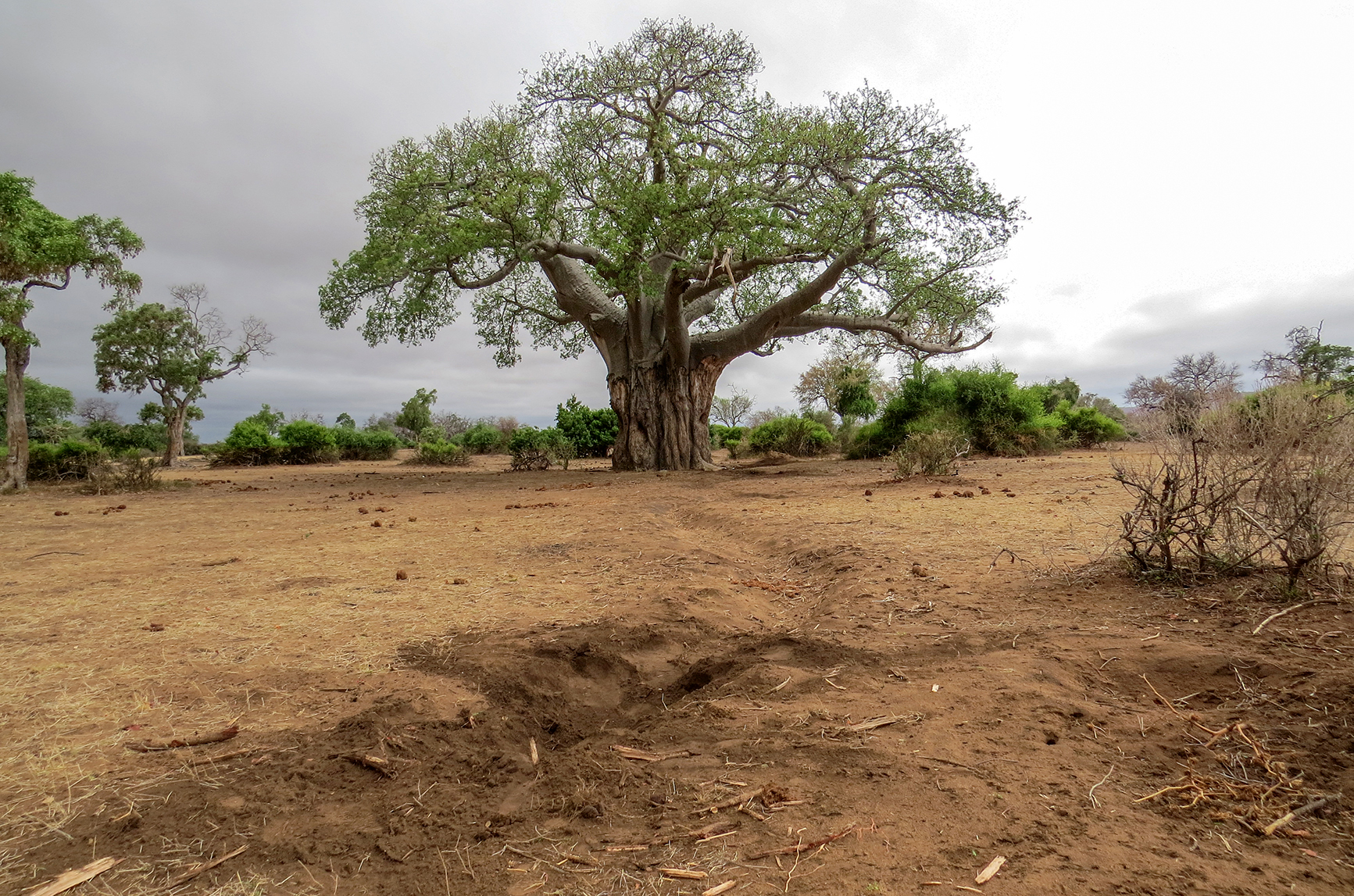
The baobab in Gonarezhou National Park, Zimbabwe, wrapped in mesh, that has had its roots eaten. (Photo: Janine Stephen)
But in the past two decades, there is the sense that baobabs in national parks such as Mapungubwe, Gonarezhou and, to a certain extent, Kruger, aren’t getting a break.
“The baobabs in [Gonarezhou] have been impacted by elephants for a long time,” says Simon Capon of the Gonarezhou Conservation Trust. “But we do feel that the impacts have increased in recent years, with many iconic baobabs ultimately felled by elephants.”
Bulls usually begin the process, stripping the bark and opening up the fibrous interior. Gouging out the pithy wood can then result in holes that extend right through the tree. If enough damage is regularly inflicted, with little recovery time, the baobab can collapse in on itself – Stockil has seen cow herds feed on such fallen giants for a week.
As observational accounts of felled trees increase, research is kicking in. Gonarezhou has around 11,000 elephants – or two animals per square kilometre. In 2016, they were more numerous than impala.
The Makuleke Contractual Park in northern Kruger has seen elephant numbers rise since community members were forced off their land in 1969. Elephant density in the Makuleke area during the 2011 dry season was well over two elephants per square kilometre. And in Mapungubwe, park manager Mphadeni Nthangeni says pachyderm numbers, especially in certain areas, are high.
“Something is happening to our mature baobabs,” says Nthangeni.
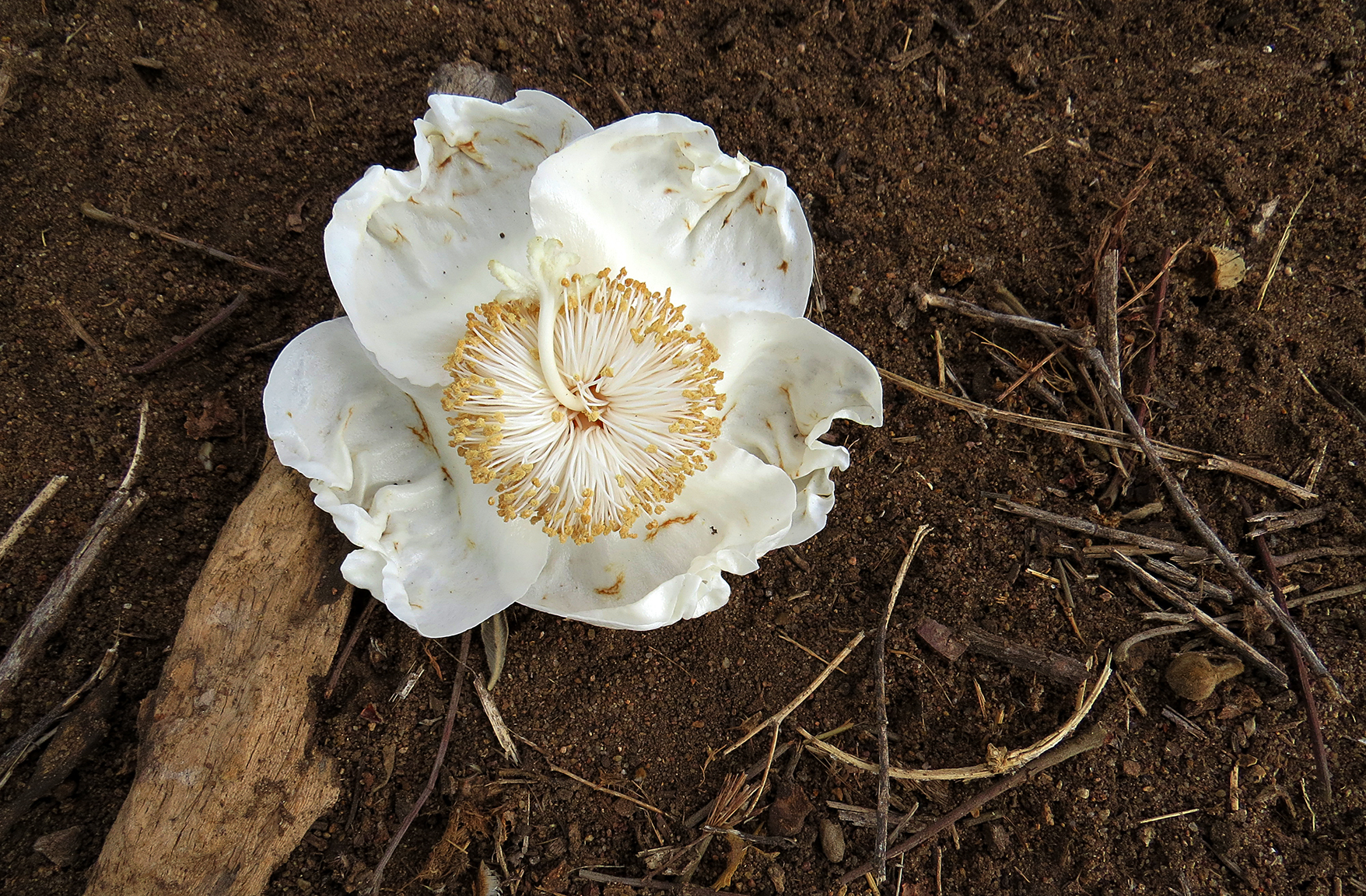
Fallen baobab flower. (Photo: Janine Stephen)
Elephants are ring-barking and gouging many of the ancient trees, but he thinks “a more complex set of circumstances” is currently to blame.
All the scientists we spoke to cited the need for more data that takes factors such as drought, security for elephant movement, and water availability into account. No one thought high elephant numbers alone were causing the uptick in damage – it’s more about why they’re utilising the trees so heavily.
Nthangeni also pointed to a dearth of young saplings in Mapungubwe.
“Where are the baby baobabs?” This is a question Dr Sarah Venter of the Baobab Foundation has asked for some years. Goats and other livestock decimate them outside parks, while wild game consumes them in protected areas. Because baobabs live for so long, it’s hard to know if this is a serious threat or just a blip in recruitment.
“If you live one-and-a-half millennia, you don’t need to be producing babies every second year,” says ecologist Dr Timothy O’Connor, who is helping Gonarezhou set up research to understand the impact of elephants on the rest of the park’s biodiversity.
“Baobab recruitment is episodic.” But even so, he says, there should be more evidence of various sizes of trees.
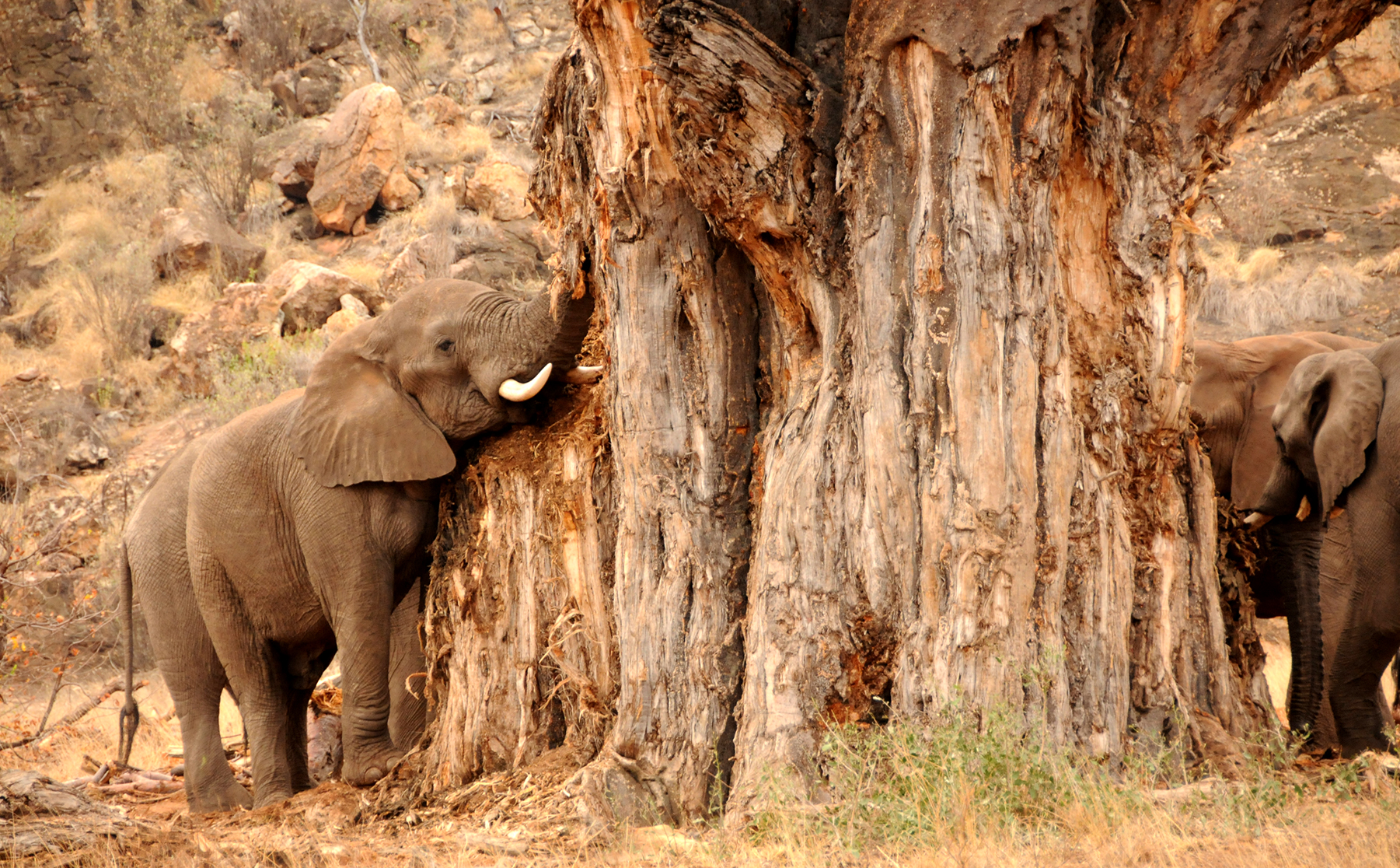
Elephants strip bark and wood from a mature baobab in Mapungubwe last September (the end of the dry season). (Photo: Cathy Greaver)
A 2020 study produced by South African National Parks’ Scientific Services reassessed data collected from 501 mature baobabs in Mapungubwe between 2005 and 2009. By 2020, eight percent of the trees had died. More conclusively, severe debarking by elephants had increased dramatically, with most trees being 76% to 100% debarked.
Dr Corli Wigley-Coetsee, a SANParks Savanna and Grassland Research Unit ecologist, agrees that elephant impact on Mapungubwe’s baobab trees has increased, with estimates of eight to 10% mortality over 15 years.
It’s not just the baobab: more preferred species, including the unfortunately named kanniedood trees (Commiphora) which are like “candy” to elephants, have largely disappeared.
“Baobab may be next on the menu in terms of palatability,” she says.
Wigley-Coetsee believes that Kruger’s baobabs are in better shape for several reasons: Kruger’s landscape is larger and less linear, with more rugged areas located further away from water. Such places provide “spatial refugia” for mature baobabs and even saplings.
Large specimens on favoured elephant routes close to water, however, can be severely damaged. To help monitor change in the future, field rangers will use apps on handheld devices to capture data on the trees’ health.
Wigley-Coetsee, Stockil and O’Connor all say that in good times, baobab should be low on elephant menus. They prefer and need grass, then will choose to browse on foliage, and turn to debarking when better food is depleted.
Mapungubwe has seen incursions of cattle from across the Limpopo River, which might be contributing to less grass for elephants. Water abstraction from mines and agriculture outside Mapungubwe could also be impacting the water table and its quality to the detriment of the ecosystem.
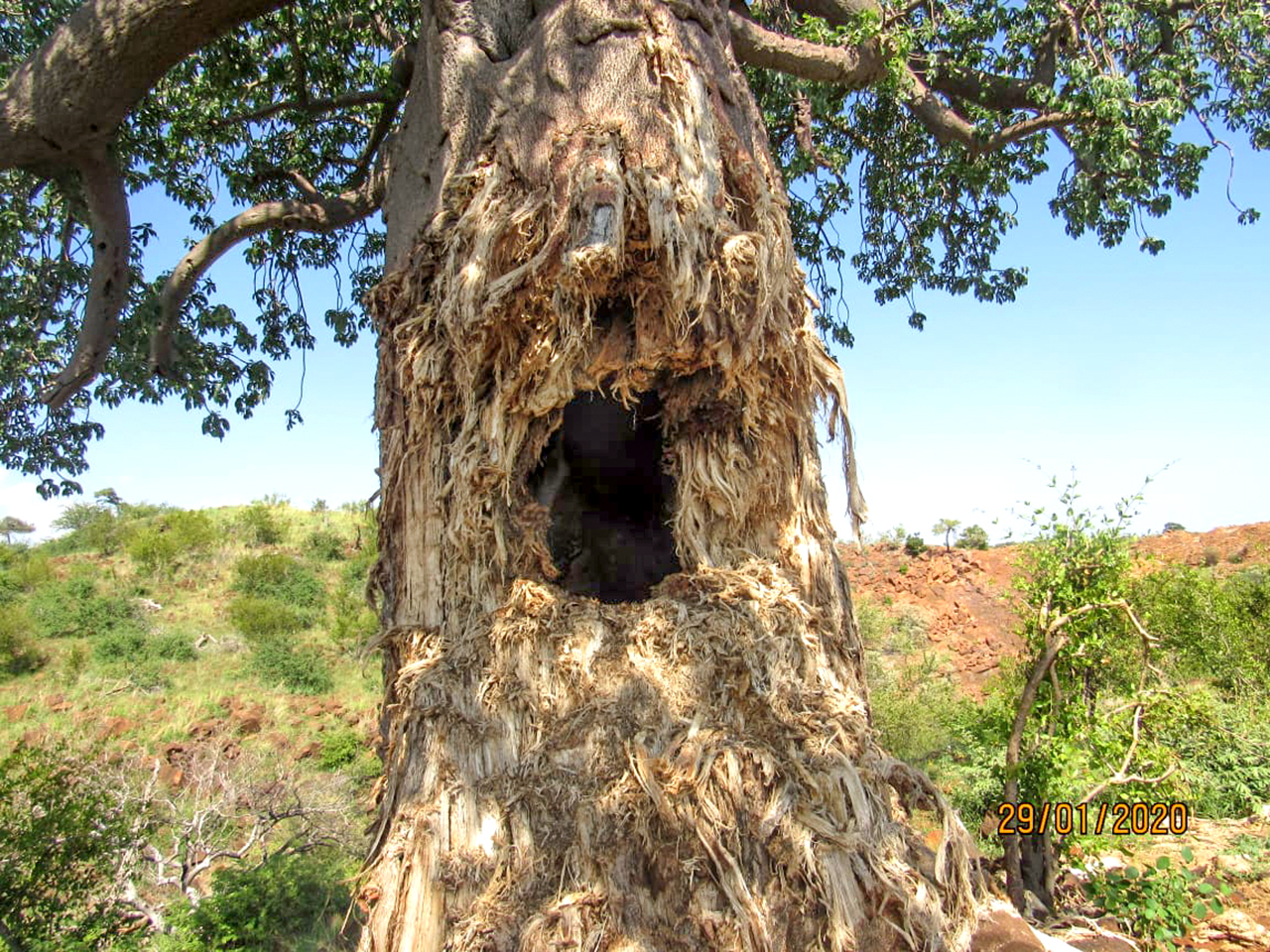
Elephant damage to a baobab in Mapungubwe National Park. (Photo: Steven Khosa)
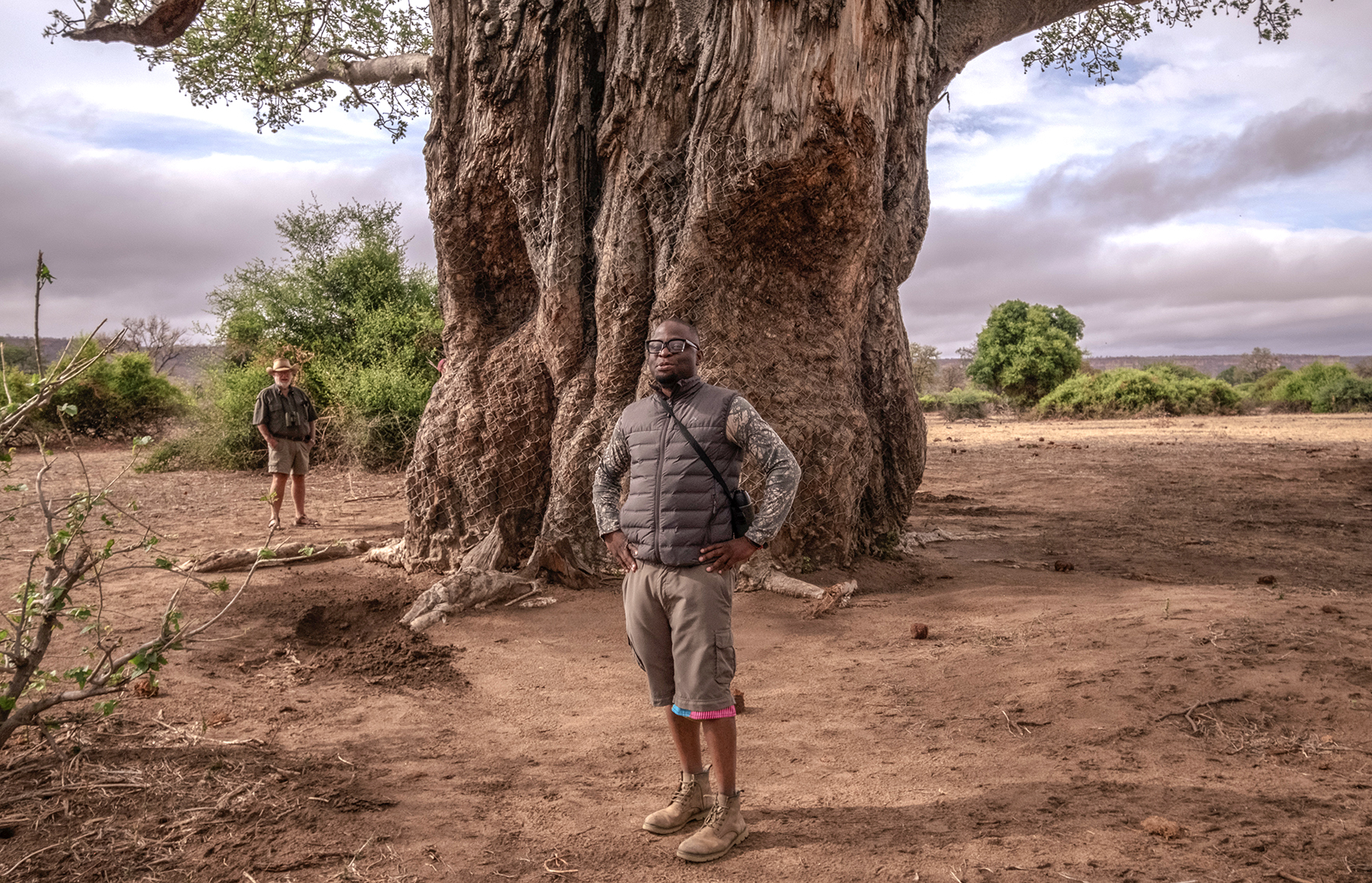
A baobab tree in Gonarezhou wrapped in mesh, with Clive Stockil of Chilo Gorge, and Gwinyai Muti, international coordinator for the Great Limpopo Transfrontier Conservation Area. (Photo: Barbara Cole)
Elephants’ excellent memories may also play a role. After years of persecution and war, the animals prefer the safety of parks and scoot through adjoining areas –even the communal lands in Transfrontier Conservation Areas that were created to be wildlife corridors. This means they spend more time feeding in parks’ desirable “high-use” zones near water, such as the riparian habitat in Mapungubwe, for longer than is ideal.
In the past, as Stockil says, people lived on the Runde’s banks before they moved out of Gonarezhou. People’s presence may have protected the trees. Now, things have changed. The same could be said for areas along the Limpopo River in the Makuleke area of Kruger, and Mapungubwe.
Bob Mandinyenya, head of scientific services in Gonarezhou, is looking at where elephants choose to spend their time as he completes his PhD. Are elephants moving from Gonarezhou to other landscapes, and can they safely do so? Collared animals are starting to give him an idea.
So far, cows and calves have remained close to home. Some males, however, are moving across borders. One bull moved south across Zimbabwe’s Mwenezi River toward South Africa, only to turn back. It then recruited another collared bull (possibly with more uncollared companions) and made it all the way to northern Kruger.
Bulls have also made forays east through the Great Limpopo Transfrontier Conservation Area (TFCA) towards Mozambique. They have not yet reached Banhine National Park in northern Gaza Province.
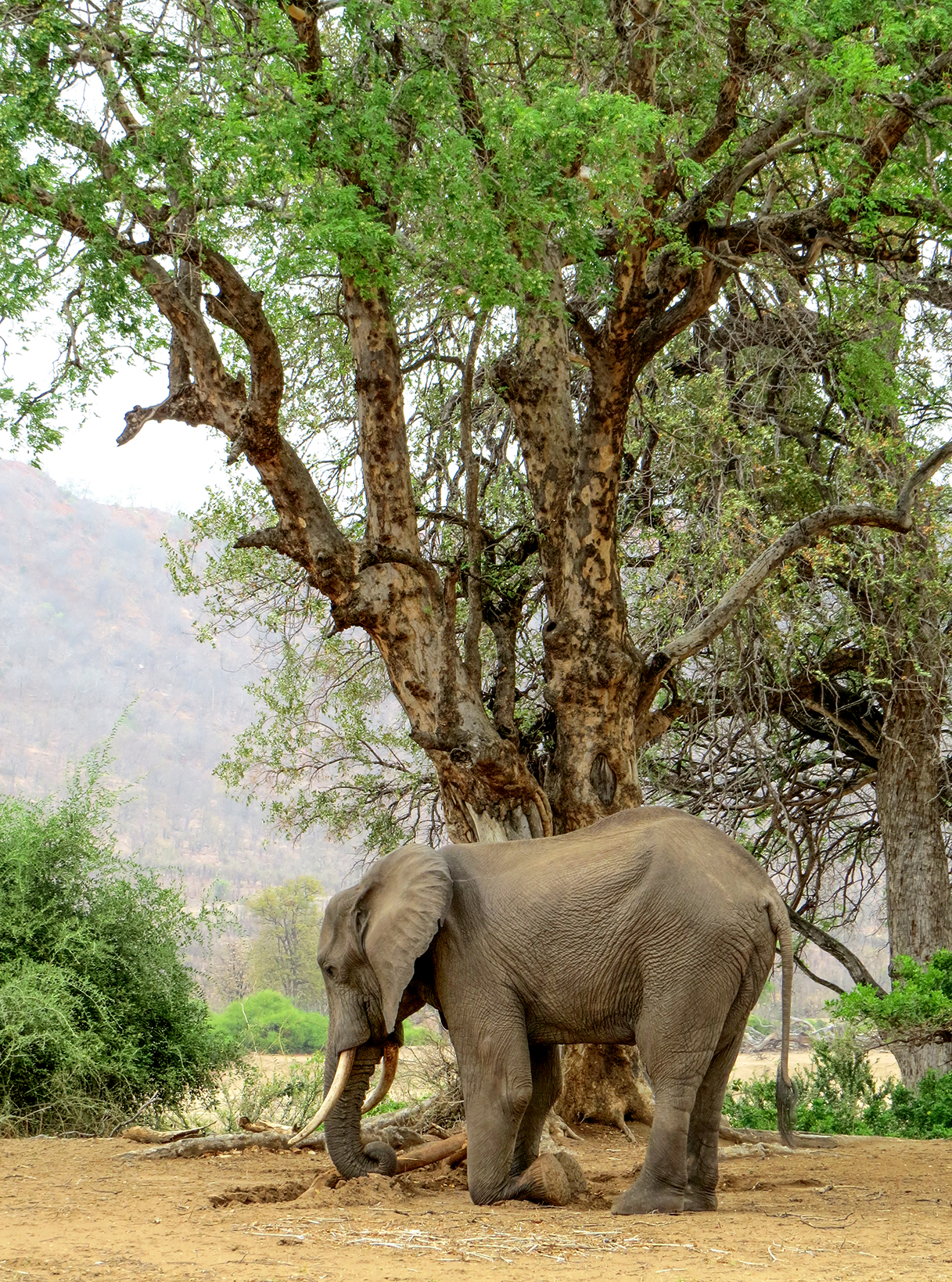
An elephant digs up the roots of a riverine tree in Gonarezhou National Park. (Photo: Janine Stephen)
“We need to encourage this movement,” says Mandinyenya. “Our elephant population is substantially high and some damage is being caused to vegetation. But other population control measures, like culling, didn’t work in the 1970s and won’t work now.
“Movement to areas like Banhine, which has under 200 elephants, is ideal.”
Wigley-Coetsee also has high hopes for the TFCAs.
“As long as we create safe corridors, I think they will move. Through studying the genetics of Kruger elephants, we know they go to Zimbabwe, to Gonarezhou, and even all the way to Chobe. It’s important to create these corridors to relieve seasonal pressure.”
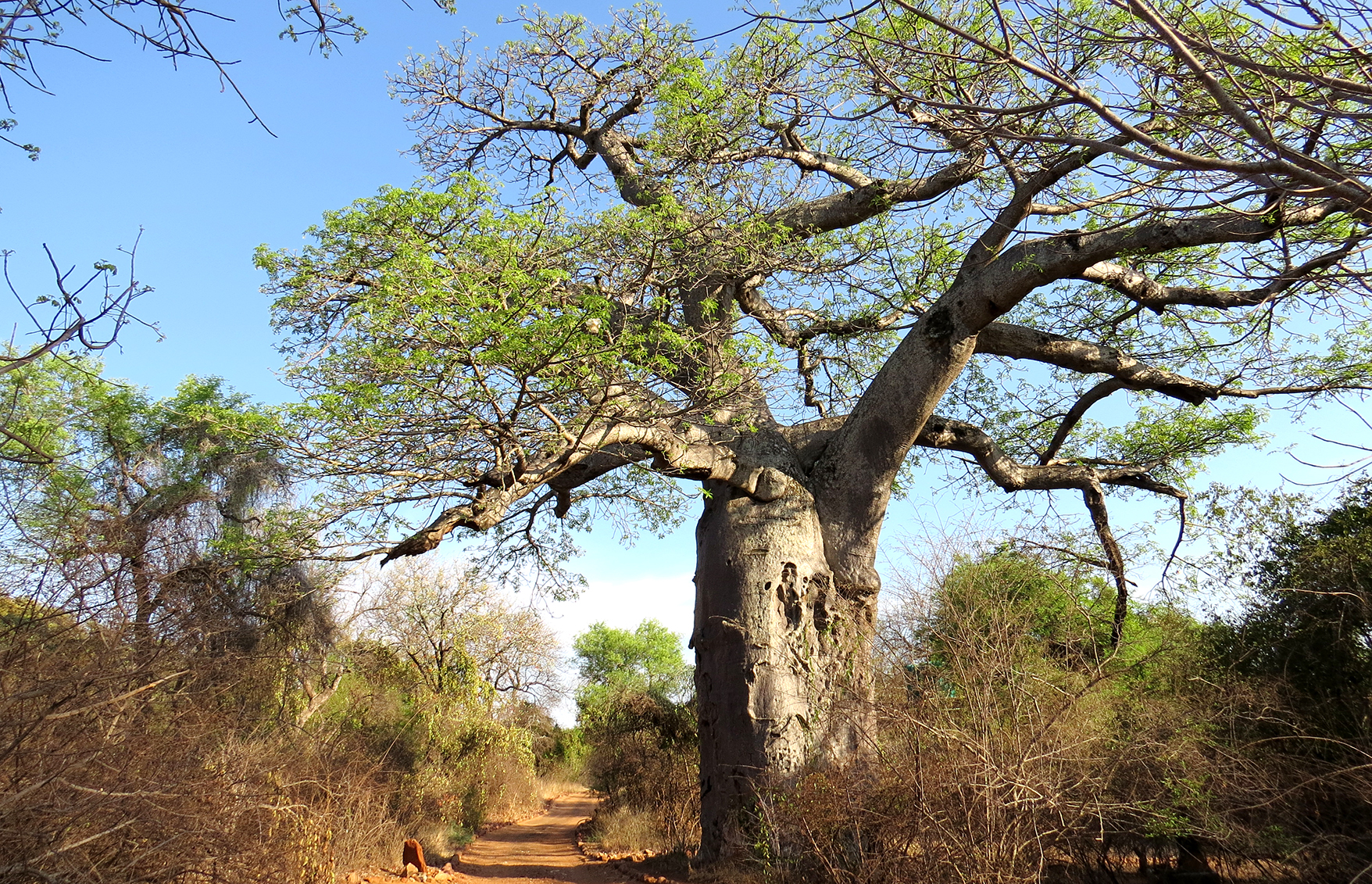
A healthy mature baobab growing outside the Kruger National Park in the Pafuri region. (Photo: Janine Stephen)
In the meantime, protecting iconic mature baobabs is on everyone’s agenda. In Gonarezhou, about 250 baobabs have been protected since 2015 by using wire mesh or stacking sharp stones or logs around their base.
A study by Venter on the effectiveness of diamond mesh in Mapungubwe in November 2022 was incontrovertible. It worked: there was no fresh damage to wrapped trees. Baobabs grow so slowly in dry areas that the wire would only need to be “let out” every 10 years, and the cost was about R1,800 per tree. A spray made from fermented elephant dung, on the other hand, failed – those baobabs simply got more unwanted attention.
Nthangeni says Mapungubwe “wants to protect the remaining large baobabs to ensure they produce seeds and give recruitment more of a chance”.
Apart from the occasional theft of the wire by villagers crossing the Limpopo, the problem is scale: how to protect great numbers of trees? And who should pay? The mesh wrapping in SANParks areas is usually done by generous honorary rangers, and there is no budget allocated.
Happily, baobabs as a species are not threatened. Outside parks that have loads of elephants, the adult trees stand smooth and ancient, supporting life cycles and ecosystems we’re still learning about.
Wits University master’s student Liam Taylor, for instance, will be standing sentry beside baobabs this year to see which birds utilise their resources. Highly endangered vultures rely on them for nest sites; up to 70 other species may also interact with the trees.
In a changing environment, Venter’s stance on planting and protecting baobabs in suitable areas in the event of future shocks makes sense. It takes a tree 30 to 200 years before it bears fruit, after all.
The Baobab Foundation supports this with nurseries and “baobab guardians” who grow and nurture saplings until they are large enough to be planted out (80 guardians have planted 101 trees to date).
One good thing: the Gonarezhou baobab, with its badly eaten roots, seems to be an anomaly. O’Connor is confident that such root-eating is confined to tough, end-of-dry-season times – when other forage sources are as scarce as moisture in the crispy dry landscape.
“The energy involved in digging up roots is hardly rewarded by what’s obtained,” he says. “It’s very demanding. Although there’s always an exception. There’s always some bozo out there.” DM/OBP
Janine Stephen is a freelance writer.
This story first appeared in our weekly Daily Maverick 168 newspaper, which is available countrywide for R25.






















 Become an Insider
Become an Insider
The Limpopo Department of Economic Development, Environment and Tourism (LEDET) recently gave approval for thousands of baobabs to be destroyed in the Vhembe District near Mapungubwe. The full market potential of this bioresource and others like mopane worms has not been properly determined or funded by government. The draft Vhembe Bioregional plan shows the importance of the ecosystem including keystone baobabs that will be removed to make way for the Musina Makhado special economic zone. For full details of the size structure of the population see the Protected Tree Assessment compiled for the EIA and hosted on the Enviroxcellence website. With the information on hand showing that protected areas are not enough to secure baobabs for future generations LEDET should be ashamed for allowing this special economic zone to go ahead and ignoring their own planning tool.
Shocking but nothing surprises. Thanks for the alert!
I’m glad the BS culling business isn’t happening. We can solve this another way.
The large elephant population will only stop or reduce breeding once all resources are consumed. There is a physical limit to the population as trees are slow growing in comparison to trees. Man has occupied the areas and corridors previously populated by elephant as well as the creation of permanent water holes to carry wildlife through droughts in potected areas, which is good for tourism but bad for controlling populations of many species.
Well-balanced article. Unlike many tunnel-vision people with an anti-elephant fetish, the author did not go on about culling being the only way to save baobabs. As the author points out, the issue is complex, and the basket of solutions should reflect the complexity.